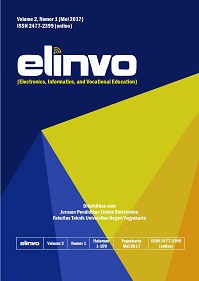Visitor Decision System in Selection of Tourist Sites Based on Hybrid of Chi-Square And K-NN Methods
DOI:
https://doi.org/10.21831/elinvo.v8i2.55702Keywords:
Decision System, Selection of Tourist Sites, Method, Chi-Square, K-Nearest NeighborsAbstract
References
L. Gorji, "Tourism Development in the Urban Side ' s Promenades ( Study Case : Barzok City ) Abstract : Tourism phenomenon is rooted in Motion and displacement and it gives mobility to human life in impartibly way . Today tourism activity is one of the most dynamic ," pp. 1–5, 2016.
C. Torng, "The Effect of Experiential Agriculture Activities on the Tourism Image of Foreign Tourists to Dai-Dai Recreational Agriculture Area in Taiwan," 2013, doi: 10.1109/CISIS.2013.125.
S. Li, S. Takahashi, K. Yamada, M. Takagi, and J. Sasaki, "Analysis of SNS Photo Data Taken by Foreign Tourists to Japan and a Proposed Adaptive Tourism Recommendation System," 2017.
C. H. C. Hsu and S. S. Huang, "Formation of Tourist Behavioral Intention and Actual Behavior," 2010.
S. Sefidpour, J. Wang, and K. Srivastava, "Factors Affecting Traveling Wave Protection".
N. Penghu, "Exploring the Relationship of Travel Constraints , Destination Image , and Revisit Intention," pp. 799–804, 2019, doi: 10.1109/IIAI-AAI.2019.00163.
H. Hongnian, Y. Qian, Z. Shuang, and W. F. Zhu, "Selection Based On Improved Artificial Bee Colony Algorithm," pp. 242–247, 2016.
V. B. Joshi and R. H. Goudar, "Searching, categorizing and tour planning: A novel approach towards e-tourism," RTEICT 2017 - 2nd IEEE Int. Conf. Recent Trends Electron. Inf. Commun. Technol. Proc., vol. 2018-Janua, pp. 1002–1005, 2017, doi: 10.1109/RTEICT.2017.8256749.
S. Hu, C. Shen, K. Zhang, and X. Huang, "Improved Wknn Indoor Positioning Algorithm Based On C-Means And Chi-Square Distance," 2019 Int. Conf. Robot. Intell. Syst., no. 2, pp. 432–435, 2019, doi: 10.1109/ICRIS.2019.00113.
M. Gí¶l, "A Modified Chi-Squares Test for Improved Bad Data Detection," no. 1, pp. 1–5.
Y. D. Setiyaningrum, "Classification of Twitter Contents using Chi-Square and K-Nearest Neighbour Algorithm," 2019 Int. Semin. Appl. Technol. Inf. Commun., pp. 1–4, 2019, doi: 10.1109/ISEMANTIC.2019.8884290.
S. Demirci, "KNN ile Ë™ Istenmeyen E-posta Filtreleme : k gerinin Sınıflandırma Performansına Etkisinin Ara ¸ stırılması Spam Filtering with KNN : Investigation of the Effect of k Value on Classification Performance," pp. 14–17, 2020.
"Data Mining Algorithms ( KNN & DT ) Based Predictive Analysis on Selected Candidates in Academic Performance," pp. 332–337, 2021.
S. xia Chen, X. kang Wang, H. yu Zhang, J. qiang Wang, and J. juan Peng, "Customer purchase forecasting for online tourism: A data-driven method with multiplex behavior data," Tour. Manag., vol. 87, no. May, p. 104357, 2021, doi: 10.1016/j.tourman.2021.104357.
C. C. Huang and H. Y. Chang, "A novel SVM-based reduced NN classification method," Proc. - 2015 11th Int. Conf. Comput. Intell. Secur. CIS 2015, pp. 62–65, 2016, doi: 10.1109/CIS.2015.23.
N. Iriadi and N. Nuraeni, "Kajian Penerapan Metode Klasifikasi Data Kelayakan Kredit Pada Bank," J. Tek. Komput. AMIK BSI, vol. II, no. 1, pp. 132–137, 2016.
M. Dixit, R. Sharma, S. Shaikh, and K. Muley, "Internet traffic detection using naí¯ve bayes and K-Nearest neighbors (KNN) algorithm," 2019 Int. Conf. Intell. Comput. Control Syst. ICCS 2019, no. Iciccs, pp. 1153–1157, 2019, doi: 10.1109/ICCS45141.2019.9065655.
H. Elmunsyah, I. A. E. Zaeni, F. A. Dwiyanto, and T. Widiyaningtyas, "Classification of Employee Mental Health Disorder Treatment With K-Nearest Neighbor Algorithm," pp. 4–8, 2019.
E. S. Gualberto, R. T. D. E. Sousa, S. Member, and C. G. Duque, "The Answer Is in the Text : Multi-Stage Methods for Phishing Detection Based on Feature Engineering," pp. 223529–223547, 2020, doi: 10.1109/ACCESS.2020.3043396.
K. Sriporn and C. F. Tsai, "Predicting Tourists' Behavior of Virtual Museum Using Support Vector Machine with Feature Selection Technique," Proc. - Int. Conf. Mach. Learn. Cybern., vol. 2, pp. 433–438, 2018, doi: 10.1109/ICMLC.2018.8526959.
B. Cheng, R. J. Stanley, S. Antani, and G. R. Thoma, "Graphical figure classification using data fusion for integrating text and image features," Proc. Int. Conf. Doc. Anal. Recognition, ICDAR, pp. 693–697, 2013, doi: 10.1109/ICDAR.2013.142.
Y. Li and B. Cheng, "An improved k-nearest neighbor algorithm and its application to high resolution remote sensing image classification," 2009 17th Int. Conf. Geoinformatics, Geoinformatics 2009, pp. 1–4, 2009, doi: 10.1109/GEOINFORMATICS.2009.5293389.
G. A. Sandag, N. E. Tedry, and S. Lolong, "Classification of Lower Back Pain Using K-Nearest Neighbor Algorithm," 2018 6th Int. Conf. Cyber IT Serv. Manag. CITSM 2018, no. Citsm, pp. 1–5, 2019, doi: 10.1109/CITSM.2018.8674361.
S. J. Saleh, S. Q. Ali, and A. M. Zeki, "Random Forest vs. SVM vs. KNN in classifying Smartphone and Smartwatch sensor data using CRISP-DM," 2020 Int. Conf. Data Anal. Bus. Ind. W. Towar. a Sustain. Econ. ICDABI 2020, pp. 28–31, 2020, doi: 10.1109/ICDABI51230.2020.9325607.
Y. Peng and H. Biao, "KNN based outlier detection algorithm in large dataset," 2008 Int. Work. Educ. Technol. Train. 2008 Int. Work. Geosci. Remote Sensing, ETT GRS 2008, vol. 1, pp. 611–613, 2008, doi: 10.1109/ETTandGRS.2008.306.
R. Patra and B. Khuntia, "Predictive Analysis of Rapid Spread of Heart Disease with Data Mining," Proc. 2019 3rd IEEE Int. Conf. Electr. Comput. Commun. Technol. ICECCT 2019, pp. 1–4, 2019, doi: 10.1109/ICECCT.2019.8869194.
Downloads
Published
How to Cite
Issue
Section
Citation Check
License
The article published in ELINVO became ELINVO's right in publication.
This work by ELINVO is licensed under a Creative Commons Attribution-NonCommercial 4.0 International License.








